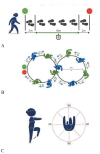Cognitive-motor dual-task training improves dynamic stability during straight and curved gait in patients with multiple sclerosis: a randomized controlled trial
- PMID: 37997324
- PMCID: PMC10932486
- DOI: 10.23736/S1973-9087.23.08156-X
Cognitive-motor dual-task training improves dynamic stability during straight and curved gait in patients with multiple sclerosis: a randomized controlled trial
Abstract
Background: Multiple Sclerosis (MS) is a chronic inflammatory, demyelinating, degenerative disease of the central nervous system and the second most frequent cause of permanent disability in young adults. One of the most common issues concerns the ability to perform postural and gait tasks while simultaneously completing a cognitive task (namely, dual-task DT).
Aim: Assessing cognitive-motor dual-task training effectiveness in patients with Multiple Sclerosis (PwMS) for dynamic gait quality when walking on straight, curved, and blindfolded paths.
Design: Two-arm single-blind randomized controlled trial. Follow-up at 8 weeks.
Setting: Neurorehabilitation Hospital.
Population: A sample of 42 PwMS aged 28-71, with a score of 4.00±1.52 on the Expanded Disability Status Scale were recruited.
Methods: Participants were randomized in conventional (CTg) neurorehabilitation and dual-task training (DTg) groups and received 12 sessions, 3 days/week/4 weeks. They were assessed at baseline (T0), after the treatment (T1), and 8 weeks after the end of the treatment (T2) through Mini-BESTest, Tinetti Performance Oriented Mobility Assessment, Modified Barthel Index, and a set of spatiotemporal parameters and gait quality indices related to stability, symmetry, and smoothness of gait extracted from initial measurement units (IMUs) data during the execution of the 10-meter Walk Test (10mWT), the Figure-of-8 Walk Test (Fo8WT) and the Fukuda Stepping Test (FST).
Results: Thirty-one PwMS completed the trial at T2. Significant improvement within subjects was found in Mini-BESTest scores for DTg from T0 to T1. The IMU-based assessment indicated significant differences in stability (P<0.01) and smoothness (P<0.05) measures between CTg and DTg during 10mWT and Fo8WT. Substantial improvements (P<0.017) were also found in the inter-session comparison, primarily for DTg, particularly for stability, symmetry, and smoothness measures.
Conclusions: This study supports the effectiveness of DT in promoting dynamic motor abilities in PwMS.
Clinical rehabilitation impact: Cognitive-motor DT implemented into the neurorehabilitation conventional program could be a useful strategy for gait and balance rehabilitation.
Conflict of interest statement
Figures




References
-
- Reich DS, Lucchinett CF, Calabresi PA. Imag(in)ing multiple sclerosis: time to take better pictures. J Neuroimmunol 2017;304:72–80. https://www.ncbi.nlm.nih.gov/entrez/query.fcgi?cmd=Retrieve&db=PubMed&l... 10.1016/j.jneuroim.2016.09.015 - DOI - PMC - PubMed
-
- Argento O, Piacentini C, Bossa M, Caltagirone C, Santamato A, Saraceni V, et al. Motor, cognitive, and combined rehabilitation approaches on MS patients’ cognitive impairment. Neurol Sci 2023;44:1109–18. https://www.ncbi.nlm.nih.gov/entrez/query.fcgi?cmd=Retrieve&db=PubMed&l... 10.1007/s10072-022-06552-4 - DOI - PMC - PubMed
-
- Kasser SL, Jacobs JV, Foley JT, Cardinal BJ, Maddalozzo GF. A prospective evaluation of balance, gait, and strength to predict falling in women with multiple sclerosis. Arch Phys Med Rehabil 2011;92:1840–6. https://www.ncbi.nlm.nih.gov/entrez/query.fcgi?cmd=Retrieve&db=PubMed&l... 10.1016/j.apmr.2011.06.004 - DOI - PubMed
-
- Chiaravalloti ND, DeLuca J. Cognitive impairment in multiple sclerosis. Lancet Neurol 2008;7:1139–51. https://www.ncbi.nlm.nih.gov/entrez/query.fcgi?cmd=Retrieve&db=PubMed&l... 10.1016/S1474-4422(08)70259-X - DOI - PubMed
-
- Plummer P, Eskes G, Wallace S, Giuffrida C, Fraas M, Campbell G, et al. American Congress of Rehabilitation Medicine Stroke Networking Group Cognition Task Force . Cognitive-motor interference during functional mobility after stroke: state of the science and implications for future research. Arch Phys Med Rehabil 2013;94:2565–2574.e6. https://www.ncbi.nlm.nih.gov/entrez/query.fcgi?cmd=Retrieve&db=PubMed&l... 10.1016/j.apmr.2013.08.002 - DOI - PMC - PubMed
Publication types
MeSH terms
LinkOut - more resources
Full Text Sources
Medical
Miscellaneous

